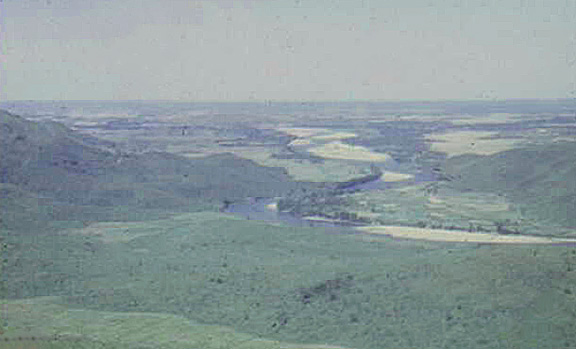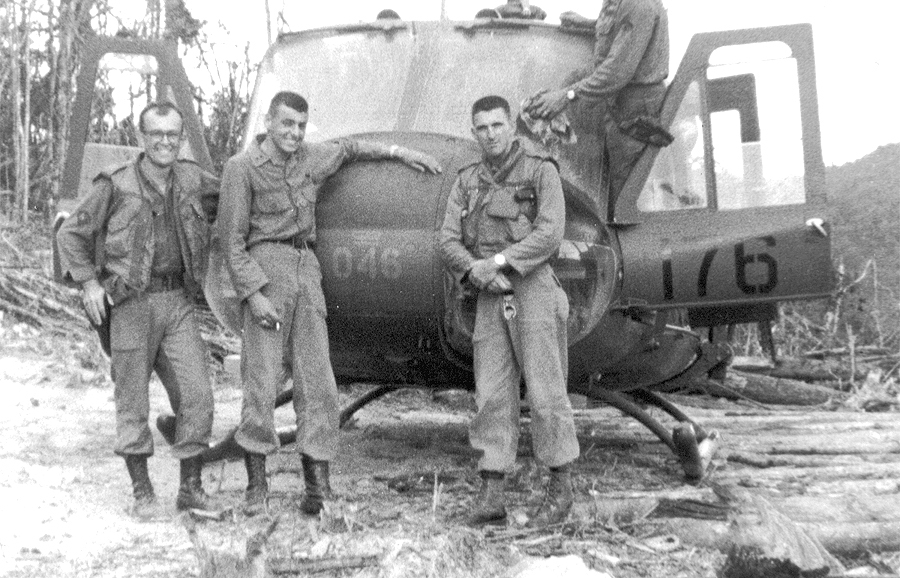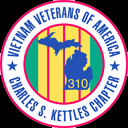MEMORABLE COMBAT EXPERIENCE
It was 15 May 1967. My unit was the 176th Avn Co (Minuteman), 14th Avn Bn. WO Roy, SP Hawley, PFC Washington and I (CPT Long) were working insertions for soldiers of the 1st Bde, 101st Airborne Div (before the rest of the division came into the country). Just after a "C" ration break, we were told to take our next load to an area about 25 kilometers NW of Duc Pho, in a valley heading west into the larger Song Ve river valley.
 |
|
Valley and river bed where the rescue took place
(Picture courtesy of LTC. Long)
|
We picked up the troops and put them in amidst a hail of machine gun, rifles, and mortar fire. WO Roy remembers that we had to fly through a wall of green tracer fire going up in front of us. As I was at the controls on the first trip in, I was so focused I must have blanked out the tracers and concentrated on the touch-down (good training did work). The soldiers off-loaded. Many were being shot a short distance away from the helicopter. At first, we thought they may have been running in front of our M60's, which we learned was not the case but is an indication of how hot the LZ was. As soon as they were off, a full load of wounded were placed aboard for evacuation. Those of the wounded who were able were urging us with their hands, eyes, and voices to "go, go, go". At that point we felt it was the normal reaction of a wounded soldier wanting to get to treatment as quickly as he could. Little did we know then that it wasn't "getting to" somewhere they were concerned with, but rather "getting away from" that particular valley. It soon became clear. As we departed, the door gunner and crew chief were calling out "machine gun 2 o'clock, machine gun 10 o'clock, machine gun left, right, etc...about 8 in all but miraculously we were able to keep flying. We weren't sure whether we were hit going in or coming out. After departure, our instrument check showed all were "in the green" so we kept flying. We took the wounded to the aid station, picked up another load of soldiers, and went back.
On our way back to the LZ, we saw the platoon leader's (Major Kettles) helicopter flying our way leaking fuel. He had been in the LZ right after us. He informed us his helicopter was badly shot up and the door gunner was severely wounded…that the ground troops needed ammo brought in and more wounded taken out, and to team up with another ship (WO Marty was one pilot, 1LT Charles the other, not sure of the rest of the crew) which had ammo for the next approach to the LZ. We led the approach. WO Roy was at the controls for this trip in with the second ship at the right echelon so the unloaded ammo would be as close as possible to the troops in the tree line. Because of where we had to land in the LZ, after the soldiers dismounted, we noticed the other soldiers who were supposed to put wounded aboard were not moving. They couldn't be blamed due to the heavy fire. Just as on the first trip, of all the soldiers jumping off to join the fray, many were being hit before making it to the tree line. Because of this, we had to wait until the second ship had off-loaded the ammo, loaded the wounded, and departed before we could relocate. It seemed like an eternity with all the bullets and mortars. The second ship reported taking many rounds, some through the cockpit but again, miraculously, without injury to the crew. Finally, we were able to hover ever closer to the tree line to minimize the soldier's exposure so they would load the wounded. In doing so we maximized our exposure, all their firepower was now concentrated on our single helicopter, and as could be expected, after lacing us with machine guns, just as we touched down they got us dead center with a mortar round, one of many falling around us. (Later, a fellow pilot who was there said he thought we were hit with an RPG round) After the bright flash was over, not being sure if we were really damaged, I checked the instruments and all were "in the green" so I pulled pitch. That was a "big" mistake since the round had made several alterations to the helicopter including making one rotor blade somewhat shorter than the other. The pitch pull caused us to flip over on the left side, then go back the other way stopping upright on the skids. I believe we all set a record at that point of "un-assing" the aircraft. In fact, Ron Roy and I both went between the pilot and co-pilot seats at the same time and do not remember touching each other. I still had my fight helmet on but the communication cord had disconnected and remained in the helicopter and I did not even feel the tug. SP Hawley and PFC Washington went to the far side of the LZ but were able to dash back across later without injury. Fortunately, even though the helicopter was destroyed, I was the only one wounded. The adrenaline was working so good I didn't know shrapnel had hit my lower right leg until I hit the ground when I jumped out. All of a sudden we were infantrymen for a while, firing at the enemy from behind our burning helicopter.
It wasn't long before the flames got to our machine gun ammo which began spraying everywhere forcing us to move to tree cover to continue to assist in the ground battle. Eventually our gunships had to depart, so "fast movers" were brought in to drop daisy cutters and napalm. The bombs were close enough that some of the shrapnel was hitting the ground behind us. This went on for an hour or so and then they left. Then our C & C ship had to leave. As the "wop, wop, wop" of those Huey blades faded in the distance and there were no more gunships or "fast movers", we realized at that moment what silence really meant. It became so quiet, for some reason it was frightening. No birds were chirping, there was no wind rustling the grass or trees, and the water in the stream to our front seemed to run quietly. A tower of smoke was rising straight up from our helicopter marking its demise. The smoke changed colors as the flames devoured different colored smoke grenades ..red, yellow, green..but eventually changed to black when the flames found the fuel. There was a low haze hovering just above the ground which smelled of gunpowder, burning helicopter, and burned flesh, a reminder that while it may be quiet, it was not over. None of us were moving for fear of making a noise which would draw unwanted attention from the bad guys. We did not know it then but later we were told that, including us, there were only 44 of us on the ground facing a much larger well-trained force on the other side of the stream. Someone also told us approximately 40 of us were wounded or dead. We saw at least one dead infantryman. (I know the hospital at Qui Nhon was filled up that day by the wounded soldiers because after my initial treatment, as I was being readied for evacuation from the 101st Medical Aid Station, I was told there was no room for me and I would be treated daily at the Aid Station.) It was clearly not a "win" day for our side.
 |
|
Retired LTC. (then Warrant Officer) Ronald Roy (center),
Retired LTC, (then Captain) Donald Long (arms crossed).
Pilots Roy and Long were awarded the Silver Star.
The aircraft pictured was destroyed by mortar rounds while wounding
Long.
(Photo Courtesy of Ronald Roy)
|
Later, after continuous exchanges of gunfire, around 1830 we heard a faint sound in the distance which told us helicopters were coming. We looked to the east and there in the sky, as beautiful as could be, were six Hueys on approach to our LZ to get us all out. It was a memorable experience to know we were not forgotten because, as mentioned earlier, we were greatly outnumbered and helicopters on approach and in the LZ were, as we had proven sitting ducks. Leading that flight was our platoon leader, Major Charles Kettles. Since he already had one chopper shot to pieces around him (over 40 bullet and shrapnel holes, plexiglass shattered, rotor blades badly ripped) and his door gunner severely wounded that day in the same LZ, he had every right not to be in the sky coming back to get us, but he was. Our helicopter and crew weren't the only ones hit that day, just the only ones hit by a mortar round and therefore, the only ones who did not leave the LZ. Besides the killed and wounded ground forces, there were also other wounded Minuteman personnel. I thank God Major Kettles argued for and got the helicopters needed to come back. Everyone knew what it meant to have been left in that area overnight with most people on the ground wounded and badly outnumbered. I'm sure no one in that LZ that evening at 1815, with the sun heading for the horizon, who was rescued because he came back, will ever forget it.
To make a long story short, everyone was extracted from the LZ that day, including the dead, amidst a withering hail of small arms and mortar fire. Because of what had happened before, WO Roy and I instructed the infantrymen around us to run with us to the furthest helicopter. It meant running through the small arms and mortar fire but it was the only way any of them would go to any but the closest helicopters. Because of my leg, two soldiers had to get on each side of me while I carried their radio, etc. As we ran we approached a wall of mortar and small arms fire but kept going. Amazingly, just before we got to the area where mortar and small arms fire was concentrated, it stopped for a few seconds. We ran through that area to the helicopter and as we got through it the fire resumed behind us. I don't attempt to explain it but am thankful it occurred.
Five of the six rescue helicopters were so badly damaged we were told they never flew again....too many repairs were needed. The helicopter flown by Maj Kettles, his second of the day, also suffered over 40 hits from small arms fire and other severe damage from the mortars.
Amazingly, on this trip in, neither he nor any of his crew were wounded. Another amazing thing is that the one helicopter which suffered only minor damage while rescuing all of us was the one we were on and that, of course, was sheer luck. It was not a Minuteman helicopter. Because there were not enough of our own available, it was "borrowed" from the 161st (Pelicans) and flown by their crew. One of the pilots was Ed (Trip) Wilson. All in all that day our unit had many wounded personnel. By the grace of God none were killed and we lost 13 helicopters (temporarily or permanently) to battle damage before it was all over. Our helicopter, which had performed brilliantly to the end, became a pile of ashes, a mechanical martyr marking the battle site. Later, as usually happens, the seriousness of the situation wore off, and our buddies began calling the area where we were blown up "Chump Valley" because only "Chumps" would be dumb enough to land on the enemy's mortar registration point. Our crew did take some ribbing about that. Since they hit us right on top, it would seem we landed on their mortar registration point.
To put this in perspective, I don't believe the 176th ever had a day quite so bad after that. I know for a fact that they had not had one even close to such intensity up to that point. The unit had been "in country" only 3 months. It was the unit's first big encounter and to that point the biggest battle participated in by 14th Avn Bn personnel and the Bn had been operational in Vietnam for apx 2 years. Our helicopter (last 3 were 046) was the first one in the 176th totally destroyed in combat and I was the first unit aviator wounded severely enough to be grounded..approximately three months..mostly due to constant infection and not the initial wound. I guess somebody and some helicopter had to be first. It may as well have been our crew and helicopter.
By any means of measurement this was by far my most memorable experience in Vietnam, one which I know is equaled by many others who served there. I'm thankful to be here to remember it. I'm very sure I would not be here or would have had years of my life taken from me if Major Kettles had not come back for all of us. Even though I'm writing this as a memorable experience, I'm only able to do so because of a memorable person, Major Charles Kettles, a really great human being and valiant soldier.
Donald E. Long
LTC, IN, Retired
 |
| Marti Long, LTC, Charles Kettles and LTC. Donald Long |
Click here to visit the 176th Assault Helicopter Company's website




